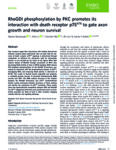In our latest paper, we show how dimers of the p75NTR neurotrophin receptor are indipensable for p75NTR-mediated cell death in the central nervous system. The paper has just been published in the Journal of Neuroscience.
The oligomeric state and activation mechanism that enable p75 NTR to mediate these effects have recently been called into question. In this new study, we have investigated mutant mice lacking the p75NTR death domain (DD) or a highly conserved transmembrane (TM) cysteine residue (Cys 259) implicated in receptor dimerization and activation. Neuronal death induced by proneurotrophins or epileptic seizures was assessed and compared with responses in p75NTR knock-out mice and wild-type animals. Proneurotrophins induced apoptosis of cultured hippocampal and cortical neurons from wild-type mice, but mutant neurons lacking p75NTR, only the p75NTR DD, or just Cys259 were all equally resistant to proneurotrophin-induced neuronal death. Homo-FRET anisotropy experiments demonstrated that both NGF and proNGF induce conformational changes in p75 NTR that are dependent on the TM cysteine. In vivo, neuronal death induced by pilocarpine-mediated seizures was significantly reduced in the hippocampus and somatosensory, piriform, and entorhinal cortices of all three strains of p75 NTR mutant mice. Interestingly, the levels of protection observed in mice lacking the DD or only Cys 259 were identical to those of p75 NTR knock-out mice even though the Cys 259 mutant differed from the wild-type receptor in only one amino acid residue. We conclude that, both in vitro and in vivo, neuronal death induced by p75NTR requires the DD and TM Cys259, supporting the physiological relevance of DD signaling by disulfide-linked dimers of p75NTR in the CNS.
Read the full paper HERE.


